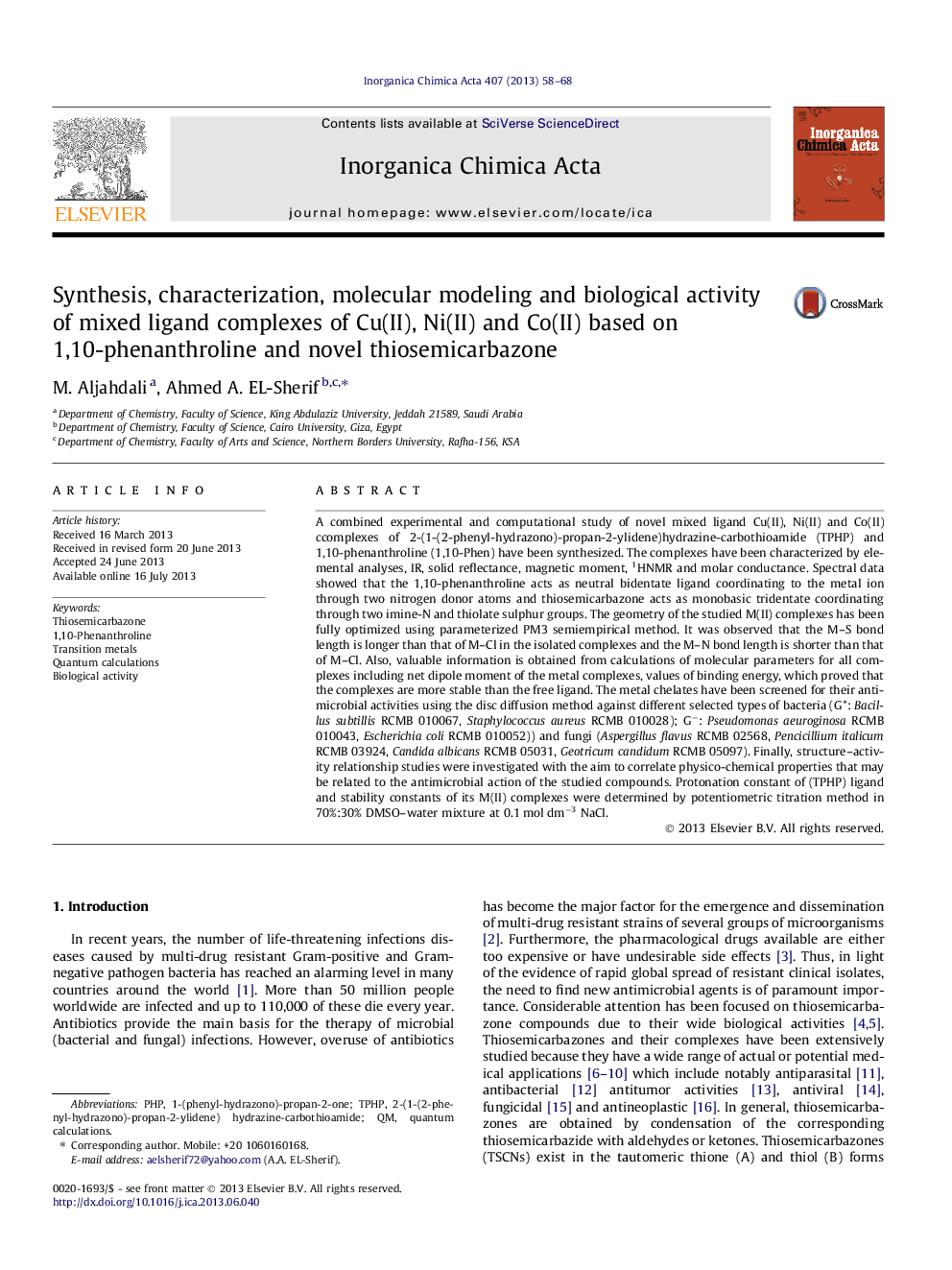| کد مقاله | کد نشریه | سال انتشار | مقاله انگلیسی | نسخه تمام متن |
|---|---|---|---|---|
| 1312254 | 1499180 | 2013 | 11 صفحه PDF | دانلود رایگان |

• Mixed bivalent transition metal complexes of phen and thiosemicarbazone were synthesized.
• Characterization of these complexes was investigated using different tools of analysis.
• Molecular modeling calculations of the compounds were performed.
• The biological activity of the free compounds and their metal-chelates were investigated.
• Structure–activity relationship was discussed
A combined experimental and computational study of novel mixed ligand Cu(II), Ni(II) and Co(II) complexes of 2-(1-(2-phenyl-hydrazono)-propan-2-ylidene)hydrazine-carbothioamide (TPHP) and 1,10-phenanthroline (1,10-Phen) have been synthesized. The complexes have been characterized by elemental analyses, IR, solid reflectance, magnetic moment, 1HNMR and molar conductance. Spectral data showed that the 1,10-phenanthroline acts as neutral bidentate ligand coordinating to the metal ion through two nitrogen donor atoms and thiosemicarbazone acts as monobasic tridentate coordinating through two imine-N and thiolate sulphur groups. The geometry of the studied M(II) complexes has been fully optimized using parameterized PM3 semiempirical method. It was observed that the M–S bond length is longer than that of M–Cl in the isolated complexes and the M–N bond length is shorter than that of M–Cl. Also, valuable information is obtained from calculations of molecular parameters for all complexes including net dipole moment of the metal complexes, values of binding energy, which proved that the complexes are more stable than the free ligand. The metal chelates have been screened for their antimicrobial activities using the disc diffusion method against different selected types of bacteria (G+: Bacillus subtillis RCMB 010067, Staphylococcus aureus RCMB 010028); G−: Pseudomonas aeuroginosa RCMB 010043, Escherichia coli RCMB 010052)) and fungi (Aspergillus flavus RCMB 02568, Pencicillium italicum RCMB 03924, Candida albicans RCMB 05031, Geotricum candidum RCMB 05097). Finally, structure–activity relationship studies were investigated with the aim to correlate physico-chemical properties that may be related to the antimicrobial action of the studied compounds. Protonation constant of (TPHP) ligand and stability constants of its M(II) complexes were determined by potentiometric titration method in 70%:30% DMSO–water mixture at 0.1 mol dm−3 NaCl.
The present paper reports on the synthesis, characterization and their electronic absorption spectra of thiosemicarbazone ligand (9TPHP) and its Cu(II), Co(II), Ni(II) and Zn(II) complexes. The antimicrobial activity was investigated. The geometry of the studied M(II) complexes has been fully optimized using parameterized PM3 semiempirical method. SAR was discussed.Figure optionsDownload as PowerPoint slide
Journal: Inorganica Chimica Acta - Volume 407, 1 October 2013, Pages 58–68